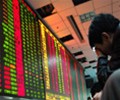Global bond investors fear more declines after vicious quarterly selloff

Fiscal concerns and worries over a prolonged period of elevated interest rates sent government bonds tumbling in the third quarter, and some investors believe more weakness is in store.
U.S. and German government bond yields were set to end September with their biggest quarterly rises in a year, disappointing fund managers who were hoping for relief from the historic losses bonds suffered in 2022, when the U.S. Federal Reserve and other central banks raised interest rates to contain surging inflation.
While bond yields – which move inversely to prices – appeared to be topping out earlier this year, renewed hawkishness from central banks has sent them soaring again in recent weeks.
In the U.S., for example, benchmark 10-year Treasury yields are now hovering around 16-year highs at 4.55%, with some investors saying they could rise to 5% – a level not seen since 2007. Treasuries are on track to post their third straight annual loss, an event without precedence in U.S. history, according to Bank of America Global Research. US/
The jump in yields is hurting equities, which are set for their first quarterly drop this year in the U.S. and Europe. With U.S. Treasury yields leading the rise, global currencies are reeling as the U.S. dollar rallies.
“The bias is finally being absorbed by the marketplace that rates will remain higher for longer,” said Greg Peters, co-chief investment officer at PGIM Fixed Income.
Monetary policy expectations have been a key driver: the Fed last week surprised investors with their hawkish projections for rates, which show borrowing costs remaining around current levels throughout most of 2024.
Investors have had to readjust swiftly, with traders now betting the Fed’s policy rate, currently at 5.25%-5.50%, will be down to 4.8% by the end of 2024, much higher than the 4.3% they foresaw at the end of August.
Similarly, investors have pushed back expectations of European Central Bank rate cuts as policymakers have stuck to their message to keep rates high for longer. Money markets pricing suggests traders see the ECB’s deposit rate is seen at around 3.5% by the end of 2024, up from around 3.25% at end-August.
NEW DRIVERS
Hawkish central banks have dulled the allure of longer-dated bonds, which with yield curves inverted, are still offering lower yields to investors than shorter-dated ones, said Kit Juckes, global head of currency strategy at Societe Generale, adding that high funding needs in the U.S. were pressuring bond markets.
“It just looks as if finding enough buyers for … all the Treasuries is requiring a price discovery process that is painful,” he said.
Prices are also being swayed by additional catalysts that have become more prominent in recent weeks, investors said.
Among them are fiscal concerns centered around the U.S., where the budget deficit has soared and a credit downgrade by ratings firm Fitch has unnerved some investors. At the same time, the Fed is progressing with “quantitative tightening” – a reversal of the massive central bank bond purchases undertaken to support markets in 2020.
As a result, “yields will rise until investors believe that longer-dated bonds are compensating them for the supply that we know is coming,” said Mike Riddell, senior portfolio manager at Allianz Global Investors.
The jump in oil prices LCOc1, which are nearing $100 a barreland up 28% so farthis quarter, is another key risk that could keep upward pressure on inflation, and therefore bond yields.
Yields on the benchmark 10-year Treasury are up nearly 76 basis points so far this quarter, on track for their largest quarterly rise in a year.
Germany’s 10-year yield DE10YT=RR, the benchmark for the euro zone, is up 52 basis points to 2.9%, the biggest quarterly jump in a year.
In Italy, 10-year yields have risen 75 basis points this month, with the debt continuing to sell off sharply on Thursday after Italy’s government hiked its budget deficit targets and cut growth forecasts.
HOW HIGH?
In addition to slamming bond investors, the rise in yields has hurt stocks, offering investment competition to equities while also raising the cost of borrowing for corporations and households.
The S&P 500 index .SPX is down 3.4% this quarter, on track for its worst fall in a year, though it is up 11.3% year-to-date. Europe’s Stoxx 600 .STOXX, meanwhile, has advanced 5.6% this year but lost 2.9% in the last three months.
Investors have been revising their views for how high yields can go. Strategists at BofA Global Research said “sticky” inflation could push the US 10-year yield to 5%, a call echoed by ING which also said Germany’s 10-year yield could see 3%.
The swift runup in yields has “overshot where fundamentals should be and put us in highly speculative territory right now,” said Ed Al-Hussainy, senior interest rate analyst at Columbia Threadneedle Investments, who believes there is a “high probability” of yields hitting 5%.
Still, some investors see opportunity, despite the turbulence.
Rick Rieder, BlackRock’s chief investment officerof Global Fixed Income, said at CNBC’s Delivering Alpha conference on Thursday that he likes shorter-dated bonds as well as the belly of the yield curve, and has also been buying commercial paper.
Noah Wise, a portfolio manager at Allspring Investments, believes yields will ease in December, when investors have a clearer view of the Fed’s monetary policy trajectory.
“When investors see the Fed is likely to stay on the sidelines, that will be a less frightening market to get involved in,” he said.
Source: Reuters (Reporting by David Randall and Yoruk Bahceli; Additional reporting by Saqib Iqbal Ahmed and Megan Davies; Editing by Ira Iosebashvili and Marguerita Choy)

 Hellenic Shipping News Worldwide Hellenic Shipping News Worldwide, Online Daily Newspaper on Hellenic and International Shipping
Hellenic Shipping News Worldwide Hellenic Shipping News Worldwide, Online Daily Newspaper on Hellenic and International Shipping





















 PG-Software
PG-Software